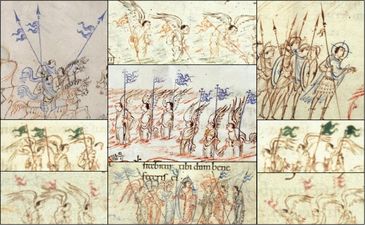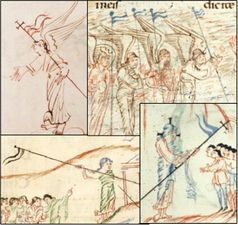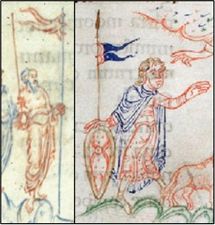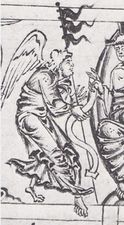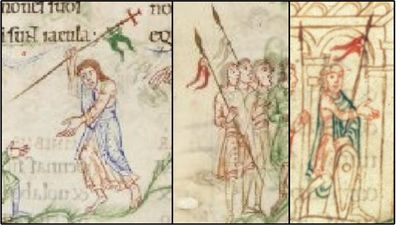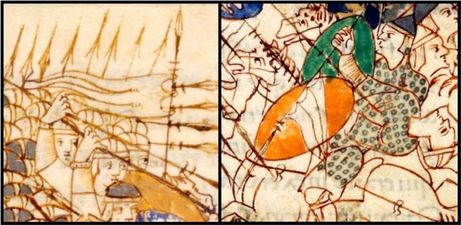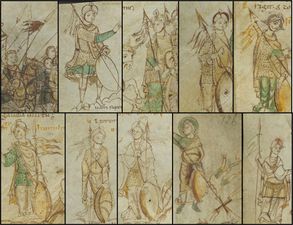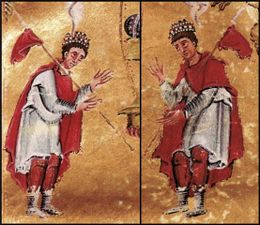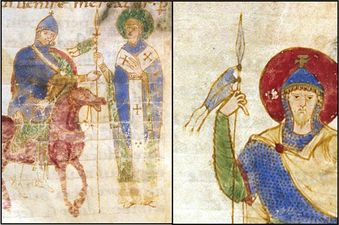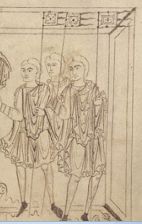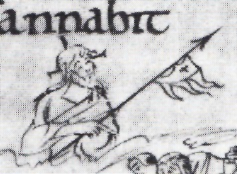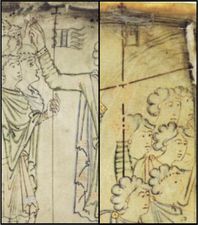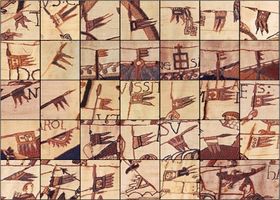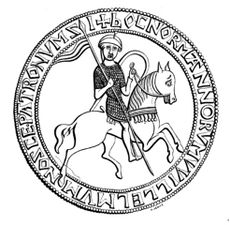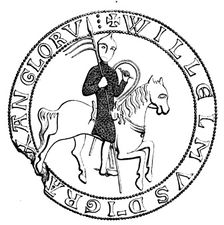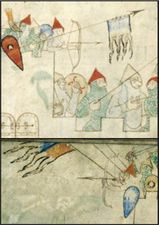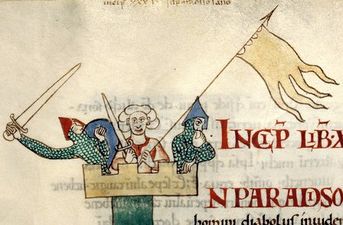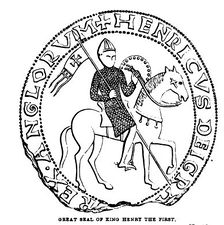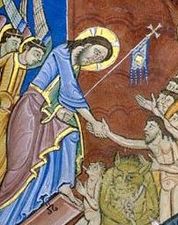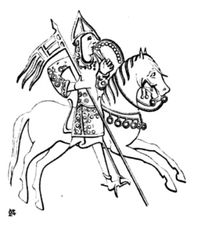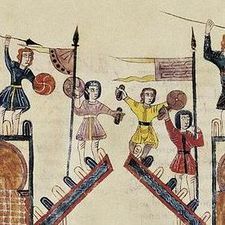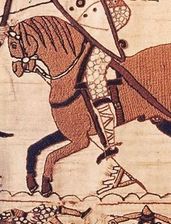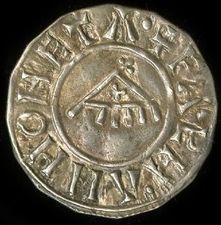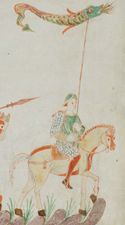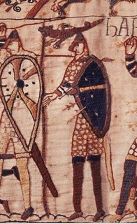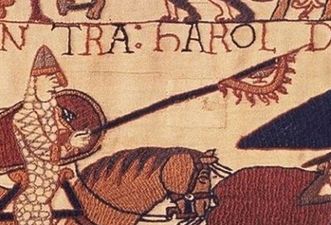Difference between revisions of "Banners"
m (→Snorri Sturluson, Heimskringla (The Chronicle of the Kings of Norway), c.1225AD) |
m |
||
| (55 intermediate revisions by the same user not shown) | |||
| Line 1: | Line 1: | ||
{{Stars2|Category=Weapons}} | {{Stars2|Category=Weapons}} | ||
| + | |||
| + | {{Spears}} | ||
Banners, standards, flags, gonfanon (gonfalon, guntfano) and pennons (pennants) were commonly adopted by the warriors of the 9th – 12th centuries. This article attempts to briefly outline what the authors currently know about the subject. The style of banner stays surprisingly consistent from the 9th to the 12th centuries and across Western Europe. For this reason we’ve decided to look at all the evidence together rather than, as we usually do, break the evidence into English, Carolingian, etc.<br> | Banners, standards, flags, gonfanon (gonfalon, guntfano) and pennons (pennants) were commonly adopted by the warriors of the 9th – 12th centuries. This article attempts to briefly outline what the authors currently know about the subject. The style of banner stays surprisingly consistent from the 9th to the 12th centuries and across Western Europe. For this reason we’ve decided to look at all the evidence together rather than, as we usually do, break the evidence into English, Carolingian, etc.<br> | ||
| Line 7: | Line 9: | ||
===Pennons=== | ===Pennons=== | ||
These are triangular flags or streamers.<br> | These are triangular flags or streamers.<br> | ||
| − | <gallery> | + | <gallery heights=150px mode="Packed" style="text-align:left"> |
File:Banner BL Harley 603 1000-1025AD.jpg | 1000-1025AD English <br> BL Harley 603 | File:Banner BL Harley 603 1000-1025AD.jpg | 1000-1025AD English <br> BL Harley 603 | ||
File:Banner BL Harley 603 1025-1050AD.jpg | 1025-1050AD English <br> BL Harley 603 | File:Banner BL Harley 603 1025-1050AD.jpg | 1025-1050AD English <br> BL Harley 603 | ||
| Line 19: | Line 21: | ||
These are rectangular flags ending in ‘swallowtails’.<br> | These are rectangular flags ending in ‘swallowtails’.<br> | ||
====Before 1066AD==== | ====Before 1066AD==== | ||
| − | <gallery> | + | <gallery heights=150px mode="Packed" style="text-align:left"> |
| − | File:Banner Leiden I Maccabees | + | File:Banner Leiden I Maccabees.jpg | 850-950AD Carolingian <br> Leiden I Maccabees f.15v & f.22r |
| − | File:Banner | + | File:Banner Brussels ms 10066-77.jpg| 900-1000AD Carolingian <br> Brussels ms 10066-77 |
| − | File:Banner Aachen Liuthar Gospels | + | File:Banner Aachen Liuthar Gospels.jpg | 990AD Ottonian <br> Aachen Liuthar Gospels |
| − | File:Banner | + | File:Banner BL Egerton 3763.jpg| 998-1018AD Ottonian <br> BL Egerton 3763 f.112v & f.116v |
| + | File:Banner BL Add. 24199.jpg| 1000AD English <br> BL Add. 24199 | ||
File:Banner BL Vatican lat.12 f.37v.jpg | 1025-10505AD English <br> BL Vatican lat.12 f.37v | File:Banner BL Vatican lat.12 f.37v.jpg | 1025-10505AD English <br> BL Vatican lat.12 f.37v | ||
File:Banner BL Paris Lat. 8824 f.1v.jpg | 1025-10505AD English <br> Paris Lat. 8824 f.1v | File:Banner BL Paris Lat. 8824 f.1v.jpg | 1025-10505AD English <br> Paris Lat. 8824 f.1v | ||
| − | File:Banner BL Cotton Tiberius C VI | + | File:Banner BL Cotton Tiberius C VI.jpg | 1050AD English <br> BL Cotton Tiberius C VI f.8v & f.9r |
| − | + | ||
</gallery> | </gallery> | ||
| Line 35: | Line 37: | ||
====After 1066AD==== | ====After 1066AD==== | ||
| − | <gallery> | + | <gallery heights=150px mode="Packed" style="text-align:left"> |
| − | File: | + | File:William Seal.jpg| 1066-1087 <br> Seal of William I (The conqueror) |
| − | File:Banner Dijon MS14 f.13v | + | File:Seal William Rufus.jpg| 1087-1100 <br> Seal of William II (Rufus) |
| + | File:Banner Dijon MS14 f.13v.jpg| 1109-1111AD French <br> Dijon MS14 f.13v | ||
File:Banner Dijon MS173 f133v.jpg| 1101-1133 French <br> Dijon MS173 f133v 'Moralia in Job' | File:Banner Dijon MS173 f133v.jpg| 1101-1133 French <br> Dijon MS173 f133v 'Moralia in Job' | ||
| − | File:Seal Henry I.jpg| 1100-1135AD English <br> | + | File:Seal Henry I.jpg| 1100-1135AD English <br> Seal of Henry I |
| + | File:Banner Heildesheim St Albans Psalter 49.JPG| 1120-1145 <br> Heildesheim, St Albans Psalter | ||
| + | File:Seal King Alexander of Scotland.jpg| 1107-1124 <br> Seal of Alexander I of Scotland | ||
</gallery> | </gallery> | ||
| + | <br> | ||
| + | ===Triangular Banners=== | ||
| + | A type of banner supported by the banner pole and a horizontal beam and similar in shape to the Viking weather vanes. | ||
| + | <gallery heights=150px mode="Packed" style="text-align:left"> | ||
| + | File:Banner Girona, Beatus Of Girona f.242r.jpg| 976AD <br> Girona, Beatus Of Girona f.242r | ||
| + | File:Banner Boulogne MS20 f.29v.jpg| 1000AD Ottonian <br> Boulogne MS20 f.29v | ||
| + | File:Banner Bayeux Tapestry 65a.jpg| c.1076AD <br> Bayeux Tapestry | ||
| + | File:Coin BM 1915,0507.767 Anlaf Guthfrithsson 939-941AD.jpg| 939-941AD <br> Anlaf Guthfrithsson, King of York | ||
| + | File:Coin Cnut.jpg| 1016-1035<br> Cnut, King of England | ||
| + | |||
| + | </gallery> | ||
<br> | <br> | ||
==From Literature== | ==From Literature== | ||
| − | < | + | For a full list of banners mentioned in primary sources see [[Banners from Literature]].<br> |
| − | ===Bede – Ecclesiastical History of the English People, 731AD=== | + | <br> |
| − | + | Included here are only those quotes that describe the appearance of banners. I have omitted those quotes that just describe the banner as golden. <br> | |
| − | + | <br> | |
| − | + | ====Bede – Ecclesiastical History of the English People, 731AD==== | |
* Osthryth, queen of the Mercians | * Osthryth, queen of the Mercians | ||
:<span style="font-style: italic; color: green">"...that there might be a perpetual memorial of the royal character of this holy man [King Oswald], they hung up over the monument his banner of gold and purple." [SELLAR 1907] | :<span style="font-style: italic; color: green">"...that there might be a perpetual memorial of the royal character of this holy man [King Oswald], they hung up over the monument his banner of gold and purple." [SELLAR 1907] | ||
| − | + | ====The Song of Roland, 1040-115AD==== | |
| − | + | ||
| − | = | + | |
| − | + | ||
| − | + | ||
| − | + | ||
| − | + | ||
| − | + | ||
| − | + | ||
| − | + | ||
| − | + | ||
| − | + | ||
| − | + | ||
| − | + | ||
| − | + | ||
| − | + | ||
| − | + | ||
| − | + | ||
| − | + | ||
| − | + | ||
| − | + | ||
| − | + | ||
| − | + | ||
| − | + | ||
| − | ===The Song of Roland, 1040-115AD=== | + | |
| − | + | ||
| − | + | ||
| − | + | ||
| − | + | ||
| − | + | ||
| − | + | ||
| − | + | ||
| − | + | ||
| − | + | ||
*Verse 39 | *Verse 39 | ||
:<span style="font-style: italic; color: green">"They held Valentian lances, and shield on shoulder wore. <br> | :<span style="font-style: italic; color: green">"They held Valentian lances, and shield on shoulder wore. <br> | ||
:<span style="font-style: italic; color: green">White and blue and vermilion were the gonfalons they bore." [BACON 1914] | :<span style="font-style: italic; color: green">White and blue and vermilion were the gonfalons they bore." [BACON 1914] | ||
| − | + | <!-- ----------------------------------------------------------------------------------------- --> | |
| − | + | <br> | |
| − | + | ==Late Roman Draco Standards== | |
| − | + | ||
| − | * | + | {{evidence |
| − | :<span style="font-style: italic; color: green">" | + | |Art = |
| − | :<span style="font-style: italic; color: green"> | + | <gallery heights=150px mode="Packed" style="text-align:left"> |
| − | : | + | File:Banner St. Gallen Cod.22 140.jpg | c.883-900AD Carolingian <br> St. Gallen Cod.22 140 |
| + | File:Banner Bayeux Tapestry 71a.jpg | c.1076AD English <br> Bayeux Tapestry | ||
| + | </gallery> | ||
| + | |Literature = | ||
| + | *About Witikind, an adversary of Charlemagne | ||
| + | :<span style="font-style: italic; color: green">"Hic arripiens signum quod apud eo habebatur sacrum, leonis atque draconis desuper aquilae volantis insignitum effigie ..." [OAKESHOTT 1960:p178] | ||
| + | * Henry of Huntingdon, Historia Anglorum c.1129-c.1154. | ||
| + | :AD 752 Battle of Burford | ||
| + | :<span style="font-style: italic; color: green">“Ethelhun who led the West-Saxons, bearing the royal standard, a golden dragon, transfixed the standard-bearer of the enemy.” [BOHN 1853:p.130] | ||
| + | :AD 1016 Battle of Assandun | ||
| + | :<span style="font-style: italic; color: green">“King Edmund distinguished himself for his valour. For perceiving that the Danes were fighting with more than ordinary vigour, he quitted his royal station which, as was wont, he had taken between the dragon and the ensign called the Standard,....” [BOHN 1853:p.194] | ||
| + | |Archaeology | ||
| − | + | |Discussion = | |
| − | :< | + | }} |
| − | + | The idea of a 'Dragon of Wessex' is an invention of E. A. Freeman in the C19th. [CHANEY 1970:p.128]<br> | |
| + | Oakeshott refers to "... be the end would have been different. But Harold was struck, and cut down by a Norman sword when William's knights burst through the Huscarles to trample down the Dragon standard and Harold's banner of the Fighting Man." [OAKESHOTT 1960:p.180] but we are unable to find anything that this reference to a dragon standard could be based on. | ||
| − | + | <!-- ----------------------------------------------------------------------------------------- --> | |
| − | + | <br> | |
| − | + | ||
| − | + | ||
| − | + | ||
| − | + | ||
| − | + | ||
| − | + | ||
| − | + | ||
| − | + | ||
| − | + | ||
| − | < | + | ==The Viking 'Raven Banner'== |
| − | === | + | {{evidence |
| + | |Art = | ||
| + | <gallery heights=150px mode="Packed" style="text-align:left"> | ||
| + | File:Banner Bayeux Tapestry 53b.jpg | c.1076AD English <br> Bayeux Tapestry | ||
| + | </gallery> | ||
| + | |Literature = | ||
| + | ====The Anglo-Saxon Chronicle (890-1116AD)==== | ||
| + | *AD 878 | ||
| + | :<span style="font-style: italic; color: green">“And in the winter of this same year the brother of Ingwar and Healfden landed in Wessex, in Devonshire, with three and twenty ships, and there was he slain, and eight hundred men with him, and forty of his army. There also was taken the war-flag, which they called the RAVEN.” [INGRAM 1912]<br> | ||
| + | Swanton’s translation [SWANTON 2000:p.77] of Anglo-Saxon Chronicle E <span style="font-style: italic; color: green">“.. and there the banner which they called ‘Raven', was taken.” </span> It's also mentioned in the Anglo-Saxon Chronicle's B, C and D (B was written in the second half of the C10th, probably in the 970's) but it is not mentioned in the oldest surviving copy of the Anglo-Saxon Chronicle, A (written from c.890AD to 1070AD). | ||
| − | + | ====Asser's The Life of Alfred (1000AD)==== | |
| − | === | + | :<span style="font-style: italic; color: green">"...and there they gained a very large booty, and amongst other things the standard called '''Raven'''; for they say that the three sisters of Hingwar and Hubba, daughters of Lodobroch, wove that flag and got it ready in one day. They say, moreover, that in every battle, wherever that flag went before them, if they were to gain the victory a '''live crow would appear flying on the middle of the flag''' ; but if they were doomed to be defeated it would hang down motionless, and this was often proved to be so. " [GILES 1848:p62] |
| − | + | A major doubt exists regarding the authenticity of this chapter in Asser's Life of Alfred. It has been fairly well proved that Bishop Parker added this chapter directly from The Annals of St Neots in his 1574AD published version of Asser's Life of Alfred. [STEVENSON 1904] The original sole surviving Anglo-Saxon manuscript, Cotton MS Otho A xii, was lost in the Cotton Library fire of 1731AD. The two remaining transcripts have both been affected to varying degrees by Bishop Parkers interpolations. | |
| − | + | ||
| − | + | ====The Annals of St Neots (1120-1140AD)==== | |
| − | === | + | :<span style="font-style: italic; color: green">""<br> |
| − | + | Although written in the C12th, The Annals of St Neots was based in part on a now missing early version of the Anglo-Saxon Chronicle. [SWANTON 2000] | |
| − | :<span style="font-style: italic; color: green"> | + | |
| − | :<span style="font-style: italic; color: green"> | + | ====Saga of Olaf, Tryggvi's Son. (c.1260AD)==== |
| + | :<span style="font-style: italic; color: green">"...Take thou here this banner which I have made with all my skill, and I ween that it will bring victory to him before whom it is borne, but death to its bearer." The banner was wrought with cunningly executed handiwork and elaborate art. It was made in the shape of a raven, and when floating in the wind it resembled the raven flying." <br> | ||
| + | This saga is part of the Flateyjarbók written between 1387AD to 1394AD and contains expanded version of some of the sagas from the Heimskringla. | ||
| − | < | + | <br> |
| − | + | |Archaeology | |
| − | + | |Discussion | |
| − | + | }} | |
| − | + | ||
| − | + | ||
| − | + | ||
| − | + | ||
| − | + | ||
| − | + | ||
| − | + | ||
| − | + | <!-- ----------------------------------------------------------------------------------------- --> | |
| − | + | <br> | |
| − | + | ||
| − | + | ||
| − | + | ==Harald Hardrade's 'Land-waster' Banner== | |
| − | + | Also known as Land-ravager. 'Landøyðan' and '' in Icelandic. <br> | |
| − | + | The Heimskringla was written around c.1230AD by Snorri Sturluson. | |
| − | + | <br> | |
| − | + | * '''Saga of Harald Hardrade.''' From the Heimskringla | |
| − | + | :* Treaty between Harald and Svein broken | |
| − | :* | + | |
::<span style="font-style: italic; color: green">"A little after this it happened that Harald and Svein one evening were sitting at table drinking and talking together, and Svein asked Harald what valuable piece of all his property he esteemed the most.<br> | ::<span style="font-style: italic; color: green">"A little after this it happened that Harald and Svein one evening were sitting at table drinking and talking together, and Svein asked Harald what valuable piece of all his property he esteemed the most.<br> | ||
::<span style="font-style: italic; color: green">He answered, it was his '''banner Land-waster'''.<br> | ::<span style="font-style: italic; color: green">He answered, it was his '''banner Land-waster'''.<br> | ||
::<span style="font-style: italic; color: green">Svein asked what was there remarkable about it, that he valued it so highly.<br> | ::<span style="font-style: italic; color: green">Svein asked what was there remarkable about it, that he valued it so highly.<br> | ||
::<span style="font-style: italic; color: green">Harald replied, it was a common saying that he must gain the victory before whom that banner is borne, and it had turned out so ever since he had owned it.<br> | ::<span style="font-style: italic; color: green">Harald replied, it was a common saying that he must gain the victory before whom that banner is borne, and it had turned out so ever since he had owned it.<br> | ||
| − | ::<span style="font-style: italic; color: green">Svein replies, "I will begin to believe there is such virtue in the banner when thou hast held three battles with thy relation Magnus, and hast gained them all."" [LAING | + | ::<span style="font-style: italic; color: green">Svein replies, "I will begin to believe there is such virtue in the banner when thou hast held three battles with thy relation Magnus, and hast gained them all."" [LAING 1907] |
| + | :* The Battle at the Humber | ||
| + | ::<span style="font-style: italic; color: green">"He ordered the '''banner''' which was called the '''Land-ravager''' to be carried before him, and made so severe an assault that all had to give way before it;" [LAING 1907] | ||
| + | :* Skirmish of Orre | ||
| + | ::<span style="font-style: italic; color: green">"Eystein Orre came up at this moment from the ships with the men who followed him, and all were clad in armour. Then Eystein got '''King Harald's banner Land-ravager'''; and now was, for the third time, one of the sharpest of conflicts, in which many Englishmen fell, and they were near to taking flight." [LAING 1907] | ||
| − | + | <!-- ----------------------------------------------------------------------------------------- --> | |
| − | + | <br> | |
| + | == Viking Weather Vanes == | ||
| + | 7 'weather vanes' have been found and a depiction of them can be found on a carving from Bergen. | ||
| − | + | <!-- ----------------------------------------------------------------------------------------- --> | |
| − | + | <br> | |
| − | + | ==King Harold’s ‘Fighting Man’ banner== | |
| + | King Harold’s personal banner is described by three sources although only two of them mention the ‘Fighting Man’. | ||
| − | + | * '''William of Poitiers, Gesta Willelmi ducis Normannorum et regis Anglorum''' (The Deeds of William, Duke of Normandy and King of England) c.1071AD | |
| − | + | <br> | |
| − | ::<span style="font-style: italic; color: green">" | + | * '''William of Malmesbury, Chronicle of the Kings of England''' (Gesta Regum Anglorum) c.1125AD |
| + | :* | ||
| + | ::<span style="font-style: italic; color: green">"The king himself on foot, stood with his brother, near the standard; in order that, while all shared equal danger, none might think of retreating. This standard William sent, after the victory, to the pope; it was sumptuously embroidered, with gold and precious stones, in the form of a '''man fighting'''." [GILES 1847:p.276] | ||
| − | + | * '''Master Wace, The Chronicle of the Norman Conquest''' (Roman de Rou), c.1174 | |
| − | ::<span style="font-style: italic; color: green"> | + | :* Line 11,450 |
| + | ::<span style="font-style: italic; color: green">“When Harold had made all ready, and given his orders, he came into the midst of the English, and dismounted by the side of the standard, Leofwin and Gurth, his brothers, were with him; and around him he had barons enough, as he stood by his gonfanon, which was in truth a noble one, sparkling with gold and precious stones. After the victory William sent it to the apostle, to prove and commemorate his great conquest and glory.” [TAYLOR 1837]</span><br> | ||
| − | + | <!-- ----------------------------------------------------------------------------------------- --> | |
| − | + | <br> | |
| + | ==The Papal Banner== | ||
| − | |||
| − | |||
| − | + | <!-- ----------------------------------------------------------------------------------------- --> | |
| − | + | <br> | |
| + | ==Charlemagne's 'Oriflame' == | ||
| − | + | ==== The song of Roland ==== | |
| − | + | *Verse 226 | |
| + | :<span style="font-style: italic; color: green">"And onwards Geoffrey of Anjou bore the great '''Oriflame''' — <br> | ||
| + | :<span style="font-style: italic; color: green">Because it was Saint Peter's, it bore the Roman name." [BACON 1914] | ||
| − | + | <!-- ----------------------------------------------------------------------------------------- --> | |
| − | + | <br> | |
| + | == The Caroccium == | ||
| − | |||
| − | |||
| − | |||
| − | |||
| − | |||
| − | |||
| − | |||
| − | |||
| − | |||
| − | |||
| − | |||
| − | |||
| − | |||
| − | |||
| − | |||
| − | |||
| − | |||
| − | |||
| − | |||
| − | |||
| + | <!-- ----------------------------------------------------------------------------------------- --> | ||
<br> | <br> | ||
==References== | ==References== | ||
| + | {{Ref|Book=Anderson, Hjjaltalin & Goudie 1873}} | ||
| + | {{Ref|Book=Bacon 1914}} | ||
| + | {{Ref|Book=Bohn 1853}} | ||
| + | {{Ref|Book=Chaney 1970}} | ||
| + | {{Ref|Book=Giles 1847}} | ||
| + | {{Ref|Book=Giles 1848}} | ||
| + | {{Ref|Book=Gummere 1910}} | ||
| + | {{Ref|Book=Hewitt 1855}} | ||
| + | {{Ref|Book=Laing 1907}} | ||
| + | {{Ref|Book=Oakeshott 1960}} | ||
| + | {{Ref|Book=Sellar 1907}} | ||
| + | {{Ref|Book=Stevenson 1904}} | ||
| + | {{Ref|Book=Swanton 2000}} | ||
| + | {{Ref|Book=Taylor 1837}} | ||
| − | |||
| − | |||
| − | |||
| − | |||
| − | |||
| − | |||
| − | |||
| − | |||
| − | |||
| − | |||
| − | |||
<HarvardReferences /> | <HarvardReferences /> | ||
Latest revision as of 19:29, 2 November 2015
| Banners |
|---|
|
More Weapons pages
Banners, standards, flags, gonfanon (gonfalon, guntfano) and pennons (pennants) were commonly adopted by the warriors of the 9th – 12th centuries. This article attempts to briefly outline what the authors currently know about the subject. The style of banner stays surprisingly consistent from the 9th to the 12th centuries and across Western Europe. For this reason we’ve decided to look at all the evidence together rather than, as we usually do, break the evidence into English, Carolingian, etc.
From Art
Pennons
These are triangular flags or streamers.
Banners
These are rectangular flags ending in ‘swallowtails’.
Before 1066AD
The Bayeux Tapestry
After 1066AD
Triangular Banners
A type of banner supported by the banner pole and a horizontal beam and similar in shape to the Viking weather vanes.
- Coin Cnut.jpg
1016-1035
Cnut, King of England
From Literature
For a full list of banners mentioned in primary sources see Banners from Literature.
Included here are only those quotes that describe the appearance of banners. I have omitted those quotes that just describe the banner as golden.
Bede – Ecclesiastical History of the English People, 731AD
- Osthryth, queen of the Mercians
- "...that there might be a perpetual memorial of the royal character of this holy man [King Oswald], they hung up over the monument his banner of gold and purple." [SELLAR 1907]
The Song of Roland, 1040-115AD
- Verse 39
- "They held Valentian lances, and shield on shoulder wore.
- White and blue and vermilion were the gonfalons they bore." [BACON 1914]
Late Roman Draco Standards
Art
Literature
- About Witikind, an adversary of Charlemagne
- "Hic arripiens signum quod apud eo habebatur sacrum, leonis atque draconis desuper aquilae volantis insignitum effigie ..." [OAKESHOTT 1960]:p178
- Henry of Huntingdon, Historia Anglorum c.1129-c.1154.
- AD 752 Battle of Burford
- “Ethelhun who led the West-Saxons, bearing the royal standard, a golden dragon, transfixed the standard-bearer of the enemy.” [BOHN 1853]:p.130
- AD 1016 Battle of Assandun
- “King Edmund distinguished himself for his valour. For perceiving that the Danes were fighting with more than ordinary vigour, he quitted his royal station which, as was wont, he had taken between the dragon and the ensign called the Standard,....” [BOHN 1853]:p.194
Archaeology
--
Discussion
The idea of a 'Dragon of Wessex' is an invention of E. A. Freeman in the C19th. [CHANEY 1970]:p.128
Oakeshott refers to "... be the end would have been different. But Harold was struck, and cut down by a Norman sword when William's knights burst through the Huscarles to trample down the Dragon standard and Harold's banner of the Fighting Man." [OAKESHOTT 1960]:p.180 but we are unable to find anything that this reference to a dragon standard could be based on.
The Viking 'Raven Banner'
Art
Literature
The Anglo-Saxon Chronicle (890-1116AD)
- AD 878
- “And in the winter of this same year the brother of Ingwar and Healfden landed in Wessex, in Devonshire, with three and twenty ships, and there was he slain, and eight hundred men with him, and forty of his army. There also was taken the war-flag, which they called the RAVEN.” [INGRAM 1912]
Swanton’s translation [SWANTON 2000]:p.77 of Anglo-Saxon Chronicle E “.. and there the banner which they called ‘Raven', was taken.” It's also mentioned in the Anglo-Saxon Chronicle's B, C and D (B was written in the second half of the C10th, probably in the 970's) but it is not mentioned in the oldest surviving copy of the Anglo-Saxon Chronicle, A (written from c.890AD to 1070AD).
Asser's The Life of Alfred (1000AD)
- "...and there they gained a very large booty, and amongst other things the standard called Raven; for they say that the three sisters of Hingwar and Hubba, daughters of Lodobroch, wove that flag and got it ready in one day. They say, moreover, that in every battle, wherever that flag went before them, if they were to gain the victory a live crow would appear flying on the middle of the flag ; but if they were doomed to be defeated it would hang down motionless, and this was often proved to be so. " [GILES 1848]:p62
A major doubt exists regarding the authenticity of this chapter in Asser's Life of Alfred. It has been fairly well proved that Bishop Parker added this chapter directly from The Annals of St Neots in his 1574AD published version of Asser's Life of Alfred. [STEVENSON 1904] The original sole surviving Anglo-Saxon manuscript, Cotton MS Otho A xii, was lost in the Cotton Library fire of 1731AD. The two remaining transcripts have both been affected to varying degrees by Bishop Parkers interpolations.
The Annals of St Neots (1120-1140AD)
- ""
Although written in the C12th, The Annals of St Neots was based in part on a now missing early version of the Anglo-Saxon Chronicle. [SWANTON 2000]
Saga of Olaf, Tryggvi's Son. (c.1260AD)
- "...Take thou here this banner which I have made with all my skill, and I ween that it will bring victory to him before whom it is borne, but death to its bearer." The banner was wrought with cunningly executed handiwork and elaborate art. It was made in the shape of a raven, and when floating in the wind it resembled the raven flying."
This saga is part of the Flateyjarbók written between 1387AD to 1394AD and contains expanded version of some of the sagas from the Heimskringla.
Archaeology
--
Discussion
--
Harald Hardrade's 'Land-waster' Banner
Also known as Land-ravager. 'Landøyðan' and in Icelandic.
The Heimskringla was written around c.1230AD by Snorri Sturluson.
- Saga of Harald Hardrade. From the Heimskringla
- Treaty between Harald and Svein broken
- "A little after this it happened that Harald and Svein one evening were sitting at table drinking and talking together, and Svein asked Harald what valuable piece of all his property he esteemed the most.
- He answered, it was his banner Land-waster.
- Svein asked what was there remarkable about it, that he valued it so highly.
- Harald replied, it was a common saying that he must gain the victory before whom that banner is borne, and it had turned out so ever since he had owned it.
- Svein replies, "I will begin to believe there is such virtue in the banner when thou hast held three battles with thy relation Magnus, and hast gained them all."" [LAING 1907]
- The Battle at the Humber
- "He ordered the banner which was called the Land-ravager to be carried before him, and made so severe an assault that all had to give way before it;" [LAING 1907]
- Skirmish of Orre
- "Eystein Orre came up at this moment from the ships with the men who followed him, and all were clad in armour. Then Eystein got King Harald's banner Land-ravager; and now was, for the third time, one of the sharpest of conflicts, in which many Englishmen fell, and they were near to taking flight." [LAING 1907]
Viking Weather Vanes
7 'weather vanes' have been found and a depiction of them can be found on a carving from Bergen.
King Harold’s ‘Fighting Man’ banner
King Harold’s personal banner is described by three sources although only two of them mention the ‘Fighting Man’.
- William of Poitiers, Gesta Willelmi ducis Normannorum et regis Anglorum (The Deeds of William, Duke of Normandy and King of England) c.1071AD
- William of Malmesbury, Chronicle of the Kings of England (Gesta Regum Anglorum) c.1125AD
- "The king himself on foot, stood with his brother, near the standard; in order that, while all shared equal danger, none might think of retreating. This standard William sent, after the victory, to the pope; it was sumptuously embroidered, with gold and precious stones, in the form of a man fighting." [GILES 1847]:p.276
- Master Wace, The Chronicle of the Norman Conquest (Roman de Rou), c.1174
- Line 11,450
- “When Harold had made all ready, and given his orders, he came into the midst of the English, and dismounted by the side of the standard, Leofwin and Gurth, his brothers, were with him; and around him he had barons enough, as he stood by his gonfanon, which was in truth a noble one, sparkling with gold and precious stones. After the victory William sent it to the apostle, to prove and commemorate his great conquest and glory.” [TAYLOR 1837]
The Papal Banner
Charlemagne's 'Oriflame'
The song of Roland
- Verse 226
- "And onwards Geoffrey of Anjou bore the great Oriflame —
- Because it was Saint Peter's, it bore the Roman name." [BACON 1914]
The Caroccium
References










